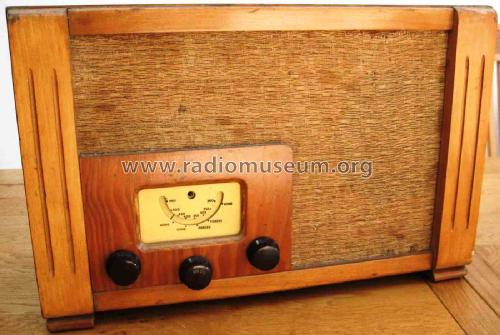Wartime Civilian Receiver Utility Set battery
Wartime Joint Enterprise
- País
- Gran Bretaña (GB)
- Fabricante / Marca
- Wartime Joint Enterprise
- Año
- 1944/1945
- Categoría
- Radio - o Sintonizador pasado WW2
- Radiomuseum.org ID
- 78259
Haga clic en la miniatura esquemática para solicitarlo como documento gratuito.
- Numero de valvulas
- 4
- Principio principal
- Superheterodino en general; ZF/IF 460 kHz
- Gama de ondas
- OM (onda media) solamente
- Tensión de funcionamiento
- Baterías recargables o pilas
- Altavoz
- -Altavoz incorporado, sistema desconocido.
- Material
- Madera
- de Radiomuseum.org
- Modelo: Wartime Civilian Receiver Utility Set [battery] - Wartime Joint Enterprise
- Forma
- Sobremesa apaisado (tamaño grande).
- Ancho, altura, profundidad
- 17.75 x 11.5 x 8 inch / 451 x 292 x 203 mm
- Anotaciones
-
Wartime civilian receiver (Battery), made by Wartime Joint Enterprise, British, 1944-1945
To overcome the shortage of broadcast receivers that developed during the Second World War, a collection of 44 British electronics and radio manufacturers came together under the banner of 'Joint Wartime Enterprise', and sponsored by the British Government, to build the "wartime civilian receiver" also known as the "utility set." The "utility set" was an inexpensive radio receiver built to a standard design by several manufacturers and for which spare parts would be easily available and could come from any manufacturer. In total, over a quarter of a million sets were produced.
Both Battery and AC mains versions were manufactured.
The radios were designed by Dr. G. D. Reynold of Murphy Radio Ltd. and those made by Murphy bore the manufacturer code U7.
They were released in June 1944 with the Battery table model at £10 19s. 0d. (inclusive of purchase tax) and the Mains table model at £12 3s. 4d. inclusive of purchase tax).
- Precio durante el primer año
- 11.00 GBP
- Mencionado en
- Radio! Radio!
- Documentación / Esquemas (1)
- Trader sheet 690
- Autor
- Modelo creado por Konrad Birkner † 12.08.2014. Ver en "Modificar Ficha" los participantes posteriores.
- Otros modelos
-
Donde encontrará 3 modelos, 2 con imágenes y 3 con esquemas.
Ir al listado general de Wartime Joint Enterprise


